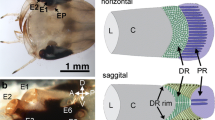Abstract
Response rates to tactile stimulation and subsequent escape speeds were measured using a video-recording system during early development and starvation of fish larvae. The species studied included the yolk-sac larvae of Clyde and Baltic herring (Clupea harengus L.), cod (Gadus morhua L.), flounder (Platichthys flesus L.) and older larvae of Clyde herring. The proportion of larvae responding (response rate) was initially about 20 to 25% in herring and 35 to 40% in cod and flounder using a probe, but about 70 to 80% using the sucking action of a pipette in all species except flounder. Both response rates and escape speeds (mean and maximum) tended to peak 1 to 2 d before the PNR (point-of-no-return, when 50% of larvae are too weak to feed), then decreased slowly during further starvation. An inter-species comparison showed that the highest recorded mean escape speeds (measured over a period of 200 ms) and highest maximum escape speeds (over 20 ms) ranged from 5.7 to 8.6 BL/s (body lengths/s) and 12.1 to 16.1 BL/s, respectively. The larvae made directional responses away from the stimulus only when they developed and reached the feeding stage.
Similar content being viewed by others
Literature cited
Bailey, K. M. and R. S. Batty: Laboratory study of predation by Aurelia aurita on larvae of cod, flounder, plaice and herring: development and vulnerability to capture. Mar. Biol. 83, 287–291 (1984)
Batty, R. S.: Observations of fish larvae in the dark with television and infra-red illumination. Mar. Biol. 76, 105–107 (1983)
Blaxter, J. H. S. and R. S. Batty: The development of startle responses in herring larvae. J. mar. biol. Ass. U.K. 65, 737–750 (1985)
Blaxter, J. H. S. and K. F. Ehrlich: Changes in behaviour during starvation of herring and plaice larvae. In: The early life history of fish, pp 575–588. Ed. by J. H. S. Blaxter. Berlin: Springer-Verlag 1974
Blaxter, J. H. S. and G. Hempel: The influence of egg size on herring larvae. J. Cons. perm. int. Explor. Mer 28, 211–240 (1963)
Eaton, R. C. and R. DiDomenico: Role of the teleost escape response during development. Trans. Am. Fish. Soc. 115, 128–142 (1986)
Eaton, R. C. and J. Nissanov: A review of Mauthner-initiated escape behaviour and its possible role in hatching in the immature zebrafish, Brachydanio rerio. Envir. Biol. Fish. 12, 265–279 (1985)
Fuiman, L. A.: Burst-swimming performance of larval zebra danios and the effects of diel temperature fluctuations. Trans. Am. Fish. Soc. 115, 143–148 (1986)
Laurence, G. C.: Comparative swimming ability of fed and starved larval large mouth bass (Micropterus salmoides). J. Fish. Biol. 4, 73–78 (1972)
Mantel, N.: Chi-square tests with one degree of freedom, extensions of the Mantel-Haenszel procedure. J. Am. statist. Ass. 58, 690–700 (1963)
Mantel, N. and W. Haenszel: Statistical aspects of the analysis of data from retrospective studies of disease. J. natn. Cancer Inst. 22, 719–748 (1959)
Swain, D. P.: Adaptive significance of variation in vertebral number in fishes: evidence in Gasterosteus aculeatus and Mylocheilus caurinus, 198 pp. Ph.D. thesis, University of British Columbia 1986
Webb, P. W.: Responses of northern anchovy, Engraulis mordax, larvae to predation by a biting planktivore, Amphiprion percula. Fish. Bull. U.S. 79, 727–735 (1981)
Webb, P. W. and R. T. Corolla: Burst swimming performance of northern anchovy, Engraulis mordax, larvae. Fish. Bull. U.S. 79, 143–150 (1981)
Weihs, D.: The mechanism of rapid starting of a slender fish. Biorheology. 10, 343–350 (1973)
Wyatt, T.: Some effects of food density on the growth and behaviour of plaice larvae. Mar. Biol. 14, 210–216 (1972)
Yin, M. C. and J. H. S. Blaxter: Morphological changes during growth and starvation of larval cod (Gadus morhua L.) and flounder (Platichthys flesus L.). J. exp. mar. Biol. Ecol. 104, 215–228 (1986)
Yin, M. C. and J. H. S. Blaxter: Feeding ability and survival during starvation of marine fish larvae reared in the laboratory. J. exp. mar. Biol. Ecol. 105, 73–83 (1987a)
Yin, M. C. and J. H. S. Blaxter: Temperature, salinity tolerance and buoyancy during early development and starvation of Clyde and North Sea herring, cod and flounder larvae. J. exp. mar. Biol. Ecol. 107, 279–290 (1987b)
Author information
Authors and Affiliations
Additional information
Communicated by J. Mauchline, Oban
Rights and permissions
About this article
Cite this article
Yin, M.C., Blaxter, J.H.S. Escape speeds of marine fish larvae during early development and starvation. Mar. Biol. 96, 459–468 (1987). https://doi.org/10.1007/BF00397963
Accepted:
Issue Date:
DOI: https://doi.org/10.1007/BF00397963




